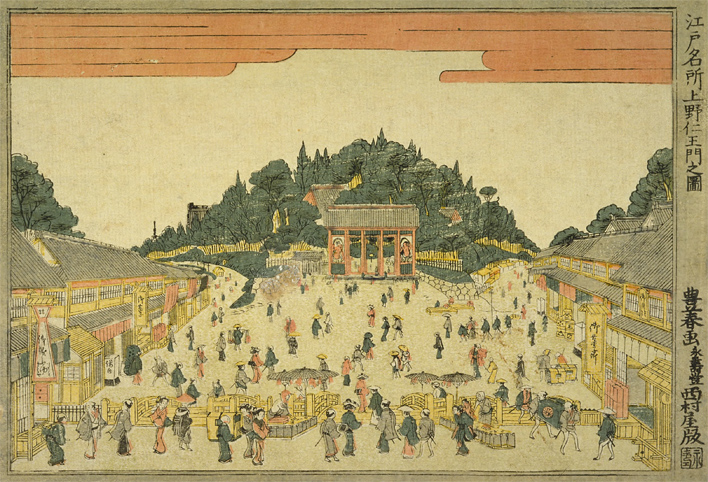
上野公園
このコラムは、平成19年に電子展示会「写真の中の明治・大正」の中で公開したコラムを移行したものです。内容は当時の記載内容に基づきます。
JR上野駅公園口を出る。右手にはロダンの彫刻のある国立西洋美術館、左手には東京文化会館…ここを過ぎると噴水のある大広場に出、ぱっと視界が開ける。この広場は、国立科学博物館、東京国立博物館、東京都美術館に囲まれ、南へ下ると、不忍池が広がる。総面積約534,000㎡の敷地の中にはまた、桜並木あり、動物園あり、五重塔あり、墓やら鳥居やら、野口英世もボードワン博士も西郷どんもいる。文化の森、緑豊かな大都会のオアシスなどと一言では括れぬ歴史がある。
「上野の山」と親しみをこめて呼ばれるこの地は、武蔵野台地のはずれ、標高約20mの上野台で、西側の本郷台との間の低地にある不忍池は、かつては海であった。土地整備が始まったのは、徳川家康の江戸入府以後のことである。寛永元(1624)年、江戸城東北の鬼門にあたるこの地に、天海僧正により寛永寺の建立が始まると、門前の上野台南麓の市街化が進んだ。京都の比叡山延暦寺に対する関東の天台宗本山として、また将軍家の菩提寺として栄え、最盛期には現在の上野公園のおよそ2倍の寺地を有し、36坊を擁する大伽藍を誇った。
しかしその偉容も、慶応4(1868)年、ここに立てこもった彰義隊と官軍との戦いによって、その大部分が焼失した。残ったのは、清水堂、東照宮、五重塔などわずかであった。
上野公園の南端(京成上野駅そば)には、官軍指揮官の一人であった西郷隆盛の像が建つ。その傍らの木立の中に、ひっそりと彰義隊の墓碑があり、山岡鉄舟の筆で「戦死之墓」と刻まれている。
この戦いの後、寛永寺境内は閉鎖され、明治元(1868)年、東京府に移管された。明治新政府は、西洋医学所(現東京大学医学部)の建設地として引渡しを求めたが、西洋医学教授のため来日中のボードワン博士が、公園とすることを進言したと言われる。
そして、6(1873)年、太政官から各府県へ達が出された。
「三府ヲ始人民輻輳ノ地ニシテ古来ノ勝区名人ノ旧跡等是迄群集遊観ノ場所東京ニ於テハ金龍山浅草寺東叡山寛永寺境内ノ類京都ニ於テハ八坂社清水ノ境内嵐山ノ類総テ社寺境内除地或ハ公有地ノ類従前高外除地ニ属セル分ハ永ク万人偕楽ノ地トシ公園ト可被相定二付府県ニ於テ右地所ヲ択ヒ其景況巨細取調図面相添ヘ大蔵省ヘ可伺出事」
『法令全書 第6巻ノ1』
これを受けた東京府は上野の地に公園設置を願い出、9(1876)年、明治天皇行幸のもと、華々しく開園式が挙行された。この後、上野公園はしばしば、明治日本の文明開化・殖産興業を演出する舞台となる。
明治期には、四度の勧業博覧会が開かれ、博物館、動物園、帝国図書館が相次いで開館、上野駅(停車場)も完成して東北地方からの玄関口となった。
「ふるさとの訛なつかし停車場の人ごみの中にそを聴きにゆく」
(石川啄木)
また、不忍池では、競馬が開かれている。第1回は、17(1884)年11月1日、明治天皇臨御のもとに開催された。翌2日の読売新聞は、その盛況ぶりを次のように伝えている。
「大競馬初日景況(前略)二十一発の大烟火(おほはなび)を打揚たり(中略)海軍省の端舟(ばうと)三艘は満艦飾をなして池中を一週し続いて第一の競馬を始められ一番(ひとつがひ)終るごとに花火の打揚げと奏楽あり此日は朝より打志ぐれたるにも拘はらず此の盛挙を見んとの人数はさしもに廣き池畔を埋め臨時に掛渡したる桟敷は人満て落るばかり上野の山にも群集したり午後六時三十分ごろ競馬終ッて還幸あらせられたり」
上野戦争の跡も癒え、桜の季節には趣向を凝らした花見行列が練り歩き、今日まで続く茶屋やレストラン(西洋軒)も店を構えた。
この間、9(1876)年には、内務省博物局所属の公園地となり、以後、博物局の移管に伴って、14(1881)年には農商務省、19(1886)年には宮内省の所管となり、23(1890)年には皇室財産(上野御料地)となっている。
大正期には、博覧会のほか、第1回メーデーの会場ともなった。大正11(1922)年、日露戦争奉天会戦記念の日に開かれた平和記念東京博覧会では、ロシア革命により日本に逃れたロマノフ将軍の令嬢マリヤがロシヤパンの店先で客寄せをしていたというエピソードもある。
12(1923)年9月1日、関東大震災がおこる。上野公園の被害は比較的少なく、住民の避難所となり、西郷隆盛の像が尋ね人の張り紙で覆われたのはこの時であった。
13(1924)年、皇太子(のちの昭和天皇)御成婚を記念して上野公園は東京市へ下賜され、「上野恩賜公園」として今日に至っている。
引用・参考文献
- 台東区産業部商業計画課[ほか]編『上野・浅草歴史散歩:重ね地図で江戸を訪ねる』東京都台東区,2003 【GC67-H117】
- 小林安茂『上野公園』改訂版.東京都公園協会,1994 【KA424-E51】
- 谷根千工房編『しのばずの池事典』谷根千工房,1989 【GC67-E80】
- 林丈二・丹尾安典『こんなに面白い上野公園』新潮社,1994 【GC67-E390】
- 中村彌六口述,吉田義季筆記『林業回顧録』大日本山林会,昭和5(1930) 【386-263】
- 大場佐一「不忍池競馬顛末記」『うえの』200号,1975.12 【Z8-424】
- 前島康彦「上野公園発祥異聞―東京公園意外史―」『都市と公園』31号,1962.8 【Z11-293】
- 内閣官報局編『法令全書 第6巻ノ1』明治22年刊の複製.原書房,1974 【CZ-4-8】
- 『東京日日新聞』大正11年3月27日 【YB-6】
- 『読売新聞』明治17年11月2日 【YB-41】
- 『日本地名大辞典.13(東京都)』角川書店,1978 【GB11-38】
- 『日本歴史地名大系.第13巻(東京都の地名)』平凡社,2002 【GB11-44】
- 『お雇い外国人. 9 医学』鹿島研究所出版会,1969 【210.61-O968】
- 宗田一[ほか]編著『医学近代化と来日外国人』世界保健通信社,1988 【SC28-E7】
:::







